 Intellectual property litigation analytics firm Lex Machina has recently released a report identifying trends in IP litigation which have played out over the course of the first quarter of 2016. The first quarter saw some interesting developments in regards to decreases in certain types of litigation throughout the IP world. In fact, it could be argued that the number of IP cases filed were trending downward across the board during 2016’s first quarter.
Intellectual property litigation analytics firm Lex Machina has recently released a report identifying trends in IP litigation which have played out over the course of the first quarter of 2016. The first quarter saw some interesting developments in regards to decreases in certain types of litigation throughout the IP world. In fact, it could be argued that the number of IP cases filed were trending downward across the board during 2016’s first quarter.
Regular patent litigation reports released by Lex Machina in recent months have given us some insight into patterns forming over the past few years. An early January post on litigation trends during 2015 reflected steep increases in patent litigation and the dominance of certain U.S. district courts in receiving those cases. A larger 2015 patent litigation report published by Lex Machina in March showed us the top litigants and asserted patents during the course of that year.
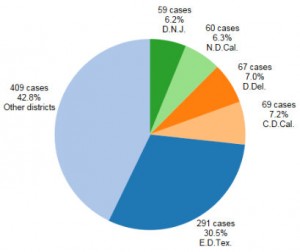 One aspect of the recent Lex Machina report that should jump out to anyone who has closely followed the patent litigation sector over the past few years is that the high percentage of all patent cases filed at the U.S. District Court for the Eastern District of Texas (E.D. Tex.) has dropped significantly. During 2015, E.D. Tex. received 43 percent of all patent infringement cases filed in American district courts. This dropped off steeply to 30 percent, or 291 cases filed, during 2016’s first quarter. For the first time since the fourth quarter of 2014, E.D. Tex.’s percentage of the nation’s patent i
One aspect of the recent Lex Machina report that should jump out to anyone who has closely followed the patent litigation sector over the past few years is that the high percentage of all patent cases filed at the U.S. District Court for the Eastern District of Texas (E.D. Tex.) has dropped significantly. During 2015, E.D. Tex. received 43 percent of all patent infringement cases filed in American district courts. This dropped off steeply to 30 percent, or 291 cases filed, during 2016’s first quarter. For the first time since the fourth quarter of 2014, E.D. Tex.’s percentage of the nation’s patent i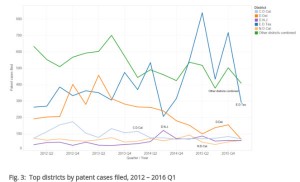 nfringement caseload dropped below the combined caseload of all district courts outside of the top five district courts in this sector. E.D. Tex. did still maintain a sizable lead over the second most popular district court venue for patent infringement cases during 2016’s first quarter, the U.S. District Court for the Central District of California (C.D. Cal.), which saw 69 case filings, 7.2 percent of the country’s patent infringement filings during the quarter.
nfringement caseload dropped below the combined caseload of all district courts outside of the top five district courts in this sector. E.D. Tex. did still maintain a sizable lead over the second most popular district court venue for patent infringement cases during 2016’s first quarter, the U.S. District Court for the Central District of California (C.D. Cal.), which saw 69 case filings, 7.2 percent of the country’s patent infringement filings during the quarter.
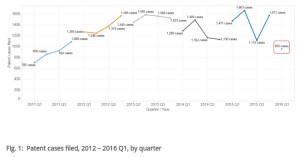 The reasons behind E.D. Tex.’s somewhat reduced stature may be strongly tied to an overall reduction in patent infringement cases filed during the recent quarter, says Lex Machina data scientist Brian Howard. In the first quarter of 2016, only 955 patent infringement cases were filed in U.S. district courts. That’s the lowest total since the third quarter of 2011, when 924 patent infringement cases were filed. It’s also a sizable drop from the last quarter of 2015, which saw 1,571 patent infringement cases filed. “It’s a bit like how a tidal wave can produce the water flowing away from the beach, naturally that way you see an entire exposed beach,” Howard said. The tidal wave referred to here happened last November, when a whopping 846 patent infringement cases were filed, almost topping 2016’s first quarter totals in one month. Last November was also the final month in which Form 18 could be used to plead patent infringement to a district court. Sensitivity to the legislative process could very well explain why patent infringement cases spiked last November, according to Howard. “The folks filing cases during that spike are not folks deciding to sue who wouldn’t have sued, but people who would have sued sooner or later, but their timeline changes,” he said.
The reasons behind E.D. Tex.’s somewhat reduced stature may be strongly tied to an overall reduction in patent infringement cases filed during the recent quarter, says Lex Machina data scientist Brian Howard. In the first quarter of 2016, only 955 patent infringement cases were filed in U.S. district courts. That’s the lowest total since the third quarter of 2011, when 924 patent infringement cases were filed. It’s also a sizable drop from the last quarter of 2015, which saw 1,571 patent infringement cases filed. “It’s a bit like how a tidal wave can produce the water flowing away from the beach, naturally that way you see an entire exposed beach,” Howard said. The tidal wave referred to here happened last November, when a whopping 846 patent infringement cases were filed, almost topping 2016’s first quarter totals in one month. Last November was also the final month in which Form 18 could be used to plead patent infringement to a district court. Sensitivity to the legislative process could very well explain why patent infringement cases spiked last November, according to Howard. “The folks filing cases during that spike are not folks deciding to sue who wouldn’t have sued, but people who would have sued sooner or later, but their timeline changes,” he said.
It was also interesting to learn that the type of plaintiff being seen less often in patent infringement filings were high-volume plaintiffs filing more than 10 cases within one year. Many of the spikes in the number of patent infringement cases, including last November’s veritable run on the district courts, creating the perceived volatility in this sector is caused by these high-volume plaintiffs. This notion is also supported by the fact that activity from low-volume plaintiffs filing less than 10 cases within one year was very consistent in recent years. “The takeaway is that high-volume patent filing parties are responsible for the volatility in filings over time,” Howard said.
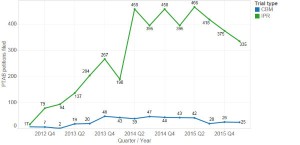 At the Patent Trial and Appeal Board (PTAB), inter partes review (IPR) filings for challenging patent validity dropped significantly for the third quarter in a row. The 335 IPRs filed during 2016’s first quarter was the lowest since 2014’s first quarter, when only 190 IPRs were filed before exploding up to 458 IPR filings in 2014’s second quarter. IPR filings have declined steadily since 2015’s second quarter, when 466 IPRs were filed at PTAB; since then, these kind of filings have dropped by about 40 IPRs per quarter. As for covered business method (CBM) reviews at PTAB, 2016’s first quarter saw about as many CBM filings as last year’s fourth quarter, but there were only 25 CBM reviews filed at PTAB in the recent quarter. This also represented a low number compared to previous quarters, as about 40 CBM reviews had been filed each quarter between 2013’s fourth quarter and 2015’s second quarter. “It would not seem to be an unreasonable conclusion that [the financial services and products] sector would be more stable than tech,” Howard said, noting that CBMs specifically target patents protecting such financial services and products.
At the Patent Trial and Appeal Board (PTAB), inter partes review (IPR) filings for challenging patent validity dropped significantly for the third quarter in a row. The 335 IPRs filed during 2016’s first quarter was the lowest since 2014’s first quarter, when only 190 IPRs were filed before exploding up to 458 IPR filings in 2014’s second quarter. IPR filings have declined steadily since 2015’s second quarter, when 466 IPRs were filed at PTAB; since then, these kind of filings have dropped by about 40 IPRs per quarter. As for covered business method (CBM) reviews at PTAB, 2016’s first quarter saw about as many CBM filings as last year’s fourth quarter, but there were only 25 CBM reviews filed at PTAB in the recent quarter. This also represented a low number compared to previous quarters, as about 40 CBM reviews had been filed each quarter between 2013’s fourth quarter and 2015’s second quarter. “It would not seem to be an unreasonable conclusion that [the financial services and products] sector would be more stable than tech,” Howard said, noting that CBMs specifically target patents protecting such financial services and products.
Trademark infringement filings were also down. The 782 trademark infringement cases filed in this year’s first quarter are the lowest since at least the first quarter of 2009, when 942 such cases were filed. Charts show a slow, steady decline in trademark infringement litigation over the course of about seven years despite a major spike in case filings during 2014’s third quarter. As we’ve covered with Howard in the past, that spike relates mainly to cases filed by National Football League players in the U.S. District Court for the District of Minnesota (D. Minn.) against the league for the use of player likenesses in NFL Films multimedia productions.
 Another interesting reduction in case filings could be seen in the realm of copyright infringement, especially for a particular kind of case being filed. Copyright infringement cases related to file sharing technologies had been outpacing all other kinds of copyright infringement cases filed since the fourth quarter of 2014. In the first quarter of 2016, however, only 500 cases related to file sharing technologies were filed, compared to the other 582 copyright infringement cases filed during the quarter. As we’ve noted in previous coverage, a large percentage of file sharing cases are brought forward by producers of erotic adult multimedia content. According to Howard, adult film producer Malibu Films filed 10 times as many cases as the next litigious plaintiff. In February, Malibu Media was dealt a loss in the U.S. District Court for the Northern District of Illinois (N.D. Ill.) when a federal judge handed out a summary judgement defeat against Malibu, which was suing a John Doe defendant accused of illegally downloading Malibu’s movies. “The fact that they’ve had this adverse court action, it’s interesting to see that [file sharing cases] are throttling back,” Howard said.
Another interesting reduction in case filings could be seen in the realm of copyright infringement, especially for a particular kind of case being filed. Copyright infringement cases related to file sharing technologies had been outpacing all other kinds of copyright infringement cases filed since the fourth quarter of 2014. In the first quarter of 2016, however, only 500 cases related to file sharing technologies were filed, compared to the other 582 copyright infringement cases filed during the quarter. As we’ve noted in previous coverage, a large percentage of file sharing cases are brought forward by producers of erotic adult multimedia content. According to Howard, adult film producer Malibu Films filed 10 times as many cases as the next litigious plaintiff. In February, Malibu Media was dealt a loss in the U.S. District Court for the Northern District of Illinois (N.D. Ill.) when a federal judge handed out a summary judgement defeat against Malibu, which was suing a John Doe defendant accused of illegally downloading Malibu’s movies. “The fact that they’ve had this adverse court action, it’s interesting to see that [file sharing cases] are throttling back,” Howard said.

![[IPWatchdog Logo]](https://ipwatchdog.com/wp-content/themes/IPWatchdog%20-%202023/assets/images/temp/logo-small@2x.png)

![[[Advertisement]]](https://ipwatchdog.com/wp-content/uploads/2023/01/2021-Patent-Practice-on-Demand-1.png)
![[Advertisement]](https://ipwatchdog.com/wp-content/uploads/2024/04/Patent-Litigation-Masters-2024-sidebar-700x500-1.jpg)

![[Advertisement]](https://ipwatchdog.com/wp-content/uploads/2021/12/WEBINAR-336-x-280-px.png)
![[Advertisement]](https://ipwatchdog.com/wp-content/uploads/2021/12/2021-Patent-Practice-on-Demand-recorded-Feb-2021-336-x-280.jpg)
![[Advertisement]](https://ipwatchdog.com/wp-content/uploads/2021/12/Ad-4-The-Invent-Patent-System™.png)
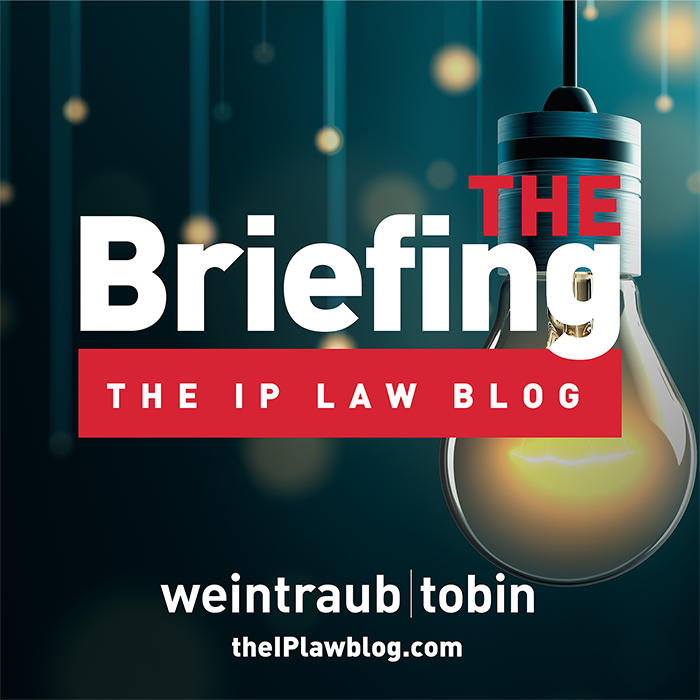





Join the Discussion
One comment so far.
Edward Heller
May 2, 2016 04:25 pmRegarding the reduced number of IPR filings: inventors and small firms have caught on that if they try to license/enforce their patents, they will be IPR’ed. So they don’t. They are abandoning the patent system.
Who could’ve predicted?